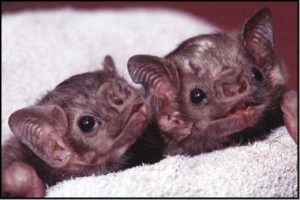Bats - vampires
 Bashny.Net
Bashny.Net

Scientists have long known that when vampires sit on the animal's skin, they begin to imbibe their razor sharp teeth into the best. not anything special, but no one knew exactly how bats determine where to bite. Exploring the wild vampire bats in South America, researchers from the University of California, San Francisco advanced his theory. Heat detectability molecules cover the nose mouse nerve endings and they are called - TRPV1. A number of pharmaceutical and biotechnology companies today are developing new pain medications on the basis of TRPV1. "The vampires feed on blood, and it's good for them, they have infrared" sensor "that can figure out the bite," said David Julius, PhD, in the field of molecular biology and medicine at UCSF, who led the study. Similar TRPV1 molecules can be found in the study of nerve fibers in the human language. They allow people to experience acute, burning and other sensations. Described this week in the journal Nature, the discovery shows how small changes in genes in the genome of species can lead to adapt over time - in this case, it allows the vampire to detect the right place for them and feed on blood. Vampires - usually for their subsistence use of horses and cows. In appearance, they are fluffy, reminiscent of a rat with wings, but bats are actually more closely tied to the evolution of dogs and horses. On the ground they move almost as well as horse races. In South American countries, they are common, vampires find their prey on the ground, after which they begin to "ride" quickly and quietly as they steal up, they bite and start to drink the blood from sleeping cows, horses or other large mammals. These bats are the only mammals that live exclusively at the expense of the blood and they need every day to drink it. They support this need through a series of evolutionary adaptation. Like other bats, they feed only at night, and they have excellent eyesight, which is amplified more acute hearing. They are able to emit high-frequency sounds that help them navigate in space. There is no fangs enamel, which retains the rigidity and strength of canine and allows them to break the delicate skin of the animal's sleep without waking him. In the language they have grooves through them they suck blood, saliva and in their anticoagulant chemicals have to hold the wound open. After the mouse did bite, it can suck the blood volume in equal half of the mouse. But first they have to find a vein, aided by their primary device: heat sensing, it allows them to "see" a vein at night. Researchers have long known that the hole on the nose vampire bat allow them to detect blood vessels because they radiate heat. But no one knew exactly how it happened. The researchers found that TRPV1 - responsible for their ability to detect heat. They also determined that it was not easy, but TRPV1 was genetic variation over time, allowing vampires to detect low-temperature space. With the help of a mechanism known as "alternative splicing" a special form of the molecule occurred in the nose bats, which has become a sensitive detector to search for hot spots.
Tags
See also
Marketing war for children
Anger is a means to relieve stress
Exercises for the memory: it is sometimes better to chew on ...
In each fridge there's food-killer. Look in your!
Well, when parents love animals, my children
Why have a headache from 3D / Part 3 entanglement angles
Interesting facts about bats
Shocking facts
Tale Frost

















